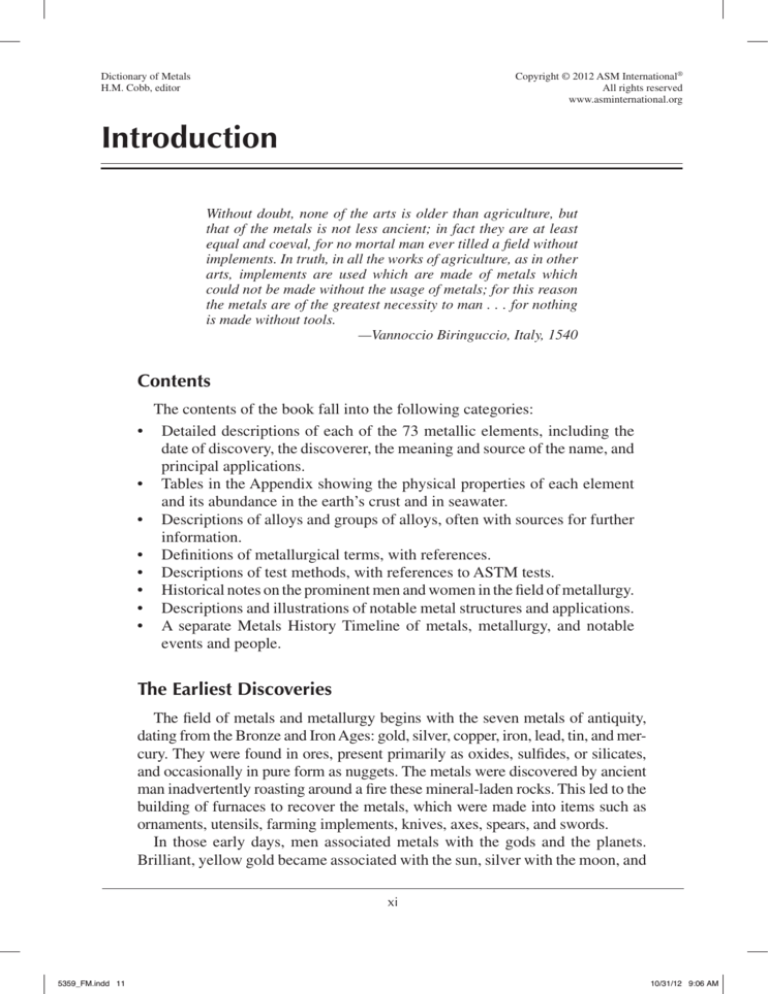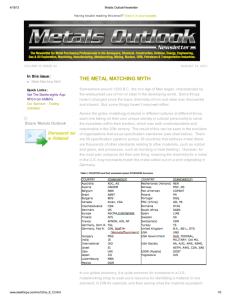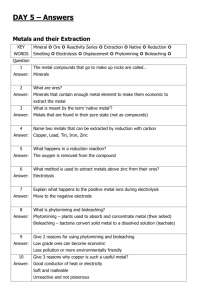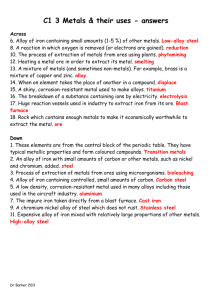
Dictionary of Metals
Copyright © 2012 ASM International®
H.M. Cobb, editor
All rights reserved
www.asminternational.org
Introduction
Without doubt, none of the arts is older than agriculture, but
that of the metals is not less ancient; in fact they are at least
equal and coeval, for no mortal man ever tilled a field without
implements. In truth, in all the works of agriculture, as in other
arts, implements are used which are made of metals which
could not be made without the usage of metals; for this reason
the metals are of the greatest necessity to man . . . for nothing
is made without tools.
—Vannoccio Biringuccio, Italy, 1540
Contents
•
•
•
•
•
•
•
•
The contents of the book fall into the following categories:
Detailed descriptions of each of the 73 metallic elements, including the
date of discovery, the discoverer, the meaning and source of the name, and
principal applications.
Tables in the Appendix showing the physical properties of each element
and its abundance in the earth’s crust and in seawater.
Descriptions of alloys and groups of alloys, often with sources for further
information.
Definitions of metallurgical terms, with references.
Descriptions of test methods, with references to ASTM tests.
Historical notes on the prominent men and women in the field of ­metallurgy.
Descriptions and illustrations of notable metal structures and ­applications.
A separate Metals History Timeline of metals, metallurgy, and notable
events and people.
The Earliest Discoveries
The field of metals and metallurgy begins with the seven metals of a­ ntiquity,
dating from the Bronze and Iron Ages: gold, silver, copper, iron, lead, tin, and mercury. They were found in ores, present primarily as ­oxides, sulfides, or silicates,
and occasionally in pure form as nuggets. The m
­ etals were discovered by ancient
man inadvertently roasting around a fire these mineral-laden rocks. This led to the
building of furnaces to recover the ­metals, which were made into items such as
ornaments, utensils, farming implements, knives, axes, spears, and swords.
In those early days, men associated metals with the gods and the ­planets.
Brilliant, yellow gold became associated with the sun, silver with the moon, and
xi
5359_FM.indd 11
10/31/12 9:06 AM
Introduction
Mars, the god of war, was for the strong metal, iron. Dark lead was associated
with the planet Saturn; the word saturnine means heavy, grave, gloomy, dull—
the opposite of mercurial. Mercury, also known as quicksilver, fell, naturally, to
Mercury, the planet that moved fastest across the sky.
The Ages of Man
In 1818, the Danish archeologist Christian Jürgensen Thomsen (1788–1865)
divided the ages of man into the Stone, Bronze, and Iron Ages, illustrating the
significance of these materials during certain periods of history. His work was
not published until 1836 when it appeared in Copenhagen in Ledetraad til Nordisk Oldkyndighed (Guideline to Scandinavian Antiquity). He did not assign
dates, but the dating of artifacts suggests the beginning of the Bronze Age from
3300 to 1200 B.C., depending upon the location. Iron implements found in the
Indian subcontinent dating back to circa 1800 B.C. indicate the earliest beginning of the Iron Age in any region. (If Thomsen were alive today, he might well
create a Steel Age that started in 1855 with Henry Bessemer’s great invention
for mass production of steel from molten pig iron.)
A copper-arsenic bronze alloy may have been the first alloy discovered,
because copper and arsenic often occurred in the same mineral. When copper was smelted, it also would be mixed with tin to form a preferred type of
bronze. The bronze alloys were harder than copper and better suited for tools
and weapons.
When iron ore was discovered, it was heated to a red heat with charcoal and
the spongy mass, called a bloom, was squeezed and hammered to remove some
of the silica slag. The 1–2% of slag remaining in the mass consisted of long thin
strings that contributed to the properties of the metal that became known first
as iron, and in the 18th century as wrought iron, apparently to ensure it was not
confused with cast iron. The product also had approximately 0.02% C. This,
then, was the iron of the Iron Age. There never was a pure form of iron, except
what was produced in modern times for experimental purposes. But the iron
worked just fine. It eventually would be the stuff of the Eiffel Tower. In addition
to its strength and malleability, iron possesses good corrosion resistance.
Although the term wrought iron is still often used for some products made
today, it is not the wrought iron of old; it is ordinary steel and will have no corrosion resistance. In 1969, the last wrought iron producer in the United States,
the A.M. Byers Company of Pittsburgh, closed its doors. Their process was
labor intensive and they could not compete with other metals.
With the discovery of all seven of the ancient metals likely having ­occurred
no later than 1000 B.C., it is interesting to note that over 2000 years passed until
the next metal was discovered. About 1250 A.D., a ­German monk by the name
xii
5359_FM.indd 12
10/31/12 9:06 AM
Introduction
of Albertus Magnus discovered arsenic. About 1450, bismuth was recognized
as a new metal by Basilius Valentinus of Erfut, Germany. He called it “wismut,”
which the early mineralogists Latinized to “bismutum.” In De Re Metallica,
published in 1556, Georgius Agricola mentioned that zinc was identified as a
metal in India in the 13th century.
During the last half of the 18th century, a dozen metals were discovered that
included, in chronological order, cobalt, nickel, manganese, molybdenum, tellurium, tungsten, uranium, zirconium, titanium, yttrium, beryllium, and chromium. It was many years before these metals were actually put to use.
The 19th century, with the Industrial Revolution in full swing, saw the discovery, in chronological order, of niobium, tantalum, iridium, palladium, rhodium, potassium, sodium, boron, barium, calcium, magnesium, strontium,
cerium, lithium, cadmium, selenium, silicon, aluminum, thorium, v­ anadium,
lanthanum, erbium, terbium, ruthenium, cesium, rubidium, thorium, indium,
and gallium.
In the early part of the 20th century, the final eight metals were discovered
(not counting the trans-uranium elements): europium, lutetium, ­hafnium, rhenium, technetium, promethium, francium, and astatine.
The Naming and Numbering of Metals
Each of the elements was called a different name in every language. Iron,
for example, was ferrum in Latin, hierro in Spanish, fer in French, and eisen
in German. But scientists in virtually every country have agreed on the same
chemical symbol for each metal, with the exception of a disagreement over
whether one element should be called columbium (Cb) or niobium (Nb). The
naturally occurring metallic elements also have atomic numbers in ­accordance
with the periodic table of elements, ranging from atomic n­ umber 3 for lithium
to number 92 for uranium.
However, the identification system for alloys, which are mixtures of two or
more chemical elements, one of which is a metal, has been far more complicated, so much so that it requires large reference books such as Stahlschlüssel
(Key to Steel), published in Germany, just to list all of the steels with their
names, numbers, and chemical compositions, for each of approximately 20
countries.
What Is a Metal?
There is no generally agreed-upon definition of metal, and there probably does not need to be. Several approaches to the subject are listed
­subsequently.
xiii
5359_FM.indd 13
10/31/12 9:06 AM
Introduction
In De Re Metallica, published in 1556, German mineralogist Georgius Agricola wrote the following description, which was translated from Latin in
1912 by future U.S. president Herbert Clark Hoover and his wife, Lou Henry
Hoover:
Metal body, by nature either liquid or somewhat hard. The latter
may be melted by the heat of fire, but when it is cooled down again and
lost all heat it becomes hard again and resumes its proper form. In this
respect it differs from the stone which melts in the fire, for although
the latter regains its hardness, yet loses its pristine form and properties.
Traditionally there are six different kinds of metals, namely gold, silver, copper, iron, tin, and lead. There are really others, for quicksilver
is a metal, although the Alchemists disagree with us on this subject,
and bismuth is also. The ancient Greek writers seem to have been ignorant of bismith [sic], wherefore Ammonius rightly states that there
are many species of metal, animals, and plants that are unknown to
us. Stibium when melted in the crucible and refined has as much right
to be regarded as a proper metal as is accorded to lead by writers. If,
when smelted, a certain amount be added to tin, a bookseller’s alloy is
produced from which the type is made that is used by those who print
books on paper. Each metal has its own form which it preserves when
separated from those metals which were mixed with it. Therefore neither electrum nor stannum is a real metal, but rather an alloy of two
metals. Electrum is an alloy of gold and silver, stannum of lead and
silver. And yet if silver is to be taken from stannum, then lead remains
and not stannum. Whether brass, however, is found as native metal or
not, cannot be ascertained by any surety. We only know of the artificial
brass, which consists of copper tinted with the color of the mineral
calamine. And yet if any should be dug up, it would be a proper metal.
Black and white copper seem to be different from the red kind. Metal,
therefore, is by nature either solid, as I have stated, or fluid, as in the
unique case of quicksilver. But enough now, concerning the simple
kinds.
In 1965, British metallurgist Donald Birchon inserted the following statement in his Dictionary of Metallurgy:
Metal. There is no rigourous definition of a metal. Earlier attempts
to define it in terms of ductility, lustre, conductivity, etc., all fail due to
anomalies or inability to be exclusive, and the chemical definition of
a substance whose hydroxide is alkaline fails since it does not define
materials having commonly accepted “metallic” properties.
A more acceptable approach is a crystalline material, in which the ions
are connected indirectly through the field of free electrons surrounding
xiv
5359_FM.indd 14
10/31/12 9:06 AM
Introduction
them. Each ion attracts as many neighboring ions as it can, giving a closepacked structure of short bonds, therefore good strength and relatively
high density, associated with good electrical and thermal conductivity,
ductility, and reflectivity.
The Nature of Metals
Everything on earth is composed of one or more of the 92 natural elements
that fall into two groups: metals and nonmetals. The nonmetals consist of the
gases hydrogen, oxygen, and nitrogen plus the inert gases argon, k­ rypton,
xenon, and neon. The other nonmetallic elements are carbon, phosphorus, sulfur, chlorine, bromine, fluorine, radon, and iodine.
The 73 naturally occurring metals are derived primarily from minerals in
the earth’s crust in the form of oxides, silicates, or sulfides. Iron, for ­example,
is found as iron oxide in several different minerals. Iron is separated from the
oxide by heating at a high temperature with coke, which provides carbon that
combines with the oxygen of the ore to allow molten iron to be produced. Many
of the smelting procedures are very complex.
Each metal is unique because its atoms are composed of a specific number of
protons, neutrons, and electrons. This means that the properties of each metal
are different. The density of each metal, for example, is different. Lead is approximately four times as heavy as aluminum. The melting points are different and vary from 238.89 °C (238 °F) for mercury to 3410 °C (6170 °F) for
­tungsten.
The thermal conductivities are mostly different, with copper and silver being
almost twice as heat conductive as aluminum. The strengths of the metals vary
considerably, and some metals are much stronger than others at elevated temperatures. Metals also have enormous differences with respect to their corrosion
resistance in various environments.
The unique properties of each metal give rise to special uses. Copper wire,
for example, is ideal for conducting electricity. Aluminum is the ideal metal
for beverage cans, and lead is the best possible metal for storage batteries for
cars. Tungsten and molybdenum are ideal for the fine filaments in incandescent
bulbs. Pure chromium metal is as brittle as glass but is applicable for the very
thin chrome plate finish on steel. Gold is the most highly prized metal for its
appearance and the most precious to own.
The Development of Alloys
Alloys are mixtures of two or more chemical elements, one of which is a
metal. For example, iron, a metal, combined with 1% or less of carbon, creates
xv
5359_FM.indd 15
10/31/12 9:06 AM
Introduction
alloys of steel. Each of the metals described previously can be combined to
make dozens or hundreds of alloys. One of the most interesting things in the
field of metallurgy is that iron and carbon can be mixed to form the greatest
number of alloys of any metal. These are primarily steels and cast irons. Some
of the steels are just iron and carbon alloys, but there are hundreds of other alloys that have been created by adding small or large amounts of chromium, molybdenum, vanadium, tungsten, and other elements. The total number of steels
is approximately 5000. The so-called tool steels are used to forge, roll, press,
and cut steels themselves and all the other metals and alloys, in addition to providing the tools and equipment necessary to produce almost everything.
xvi
5359_FM.indd 16
10/31/12 9:06 AM







